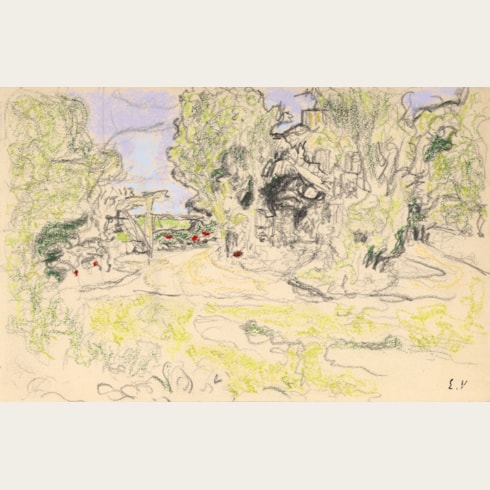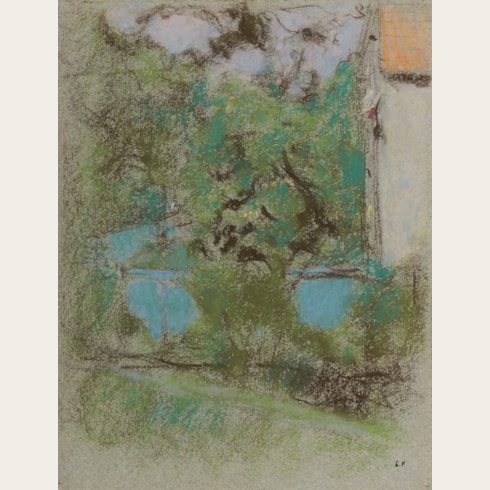Edouard VUILLARD
(Cuiseaux 1868 - La Baule 1940)
Annette at Vaucresson
Signed E Vuillard at the lower left
303 x 235 mm. (11 7/8 x 9 1/4 in.)
Born in 1898 to Vuillard’s sister Marie and the painter Ker-Xavier Roussel, Annette Roussel was, since her infancy, the subject of paintings, drawings, pastels and photographs by the artist, who was very fond of her. As a young woman, Annette spent much time at the home of her uncle, to escape the tensions caused by the unhappy marriage of her parents. During the First World War, when her father was largely confined to a sanatorium in Switzerland, she was left in the care of Vuillard and his mother in Paris. She had ‘blossomed into an elegant and stylish young woman’, and continued to appear in many of Vuillard’s paintings.
As Antoine Salomon and Guy Cogeval have described Annette Roussel, who would have been in her early twenties when this drawing was made, she was ‘a beautiful but often melancholy young lady...Vuillard was something of a second father to her, particularly during the First World War, and he never lost a chance to show how highly he thought of her...Vuillard also became Annette’s confidant. In her letters she wrote to her father, she would reel off a string of news in a rather humdrum manner. With her ‘dear little uncle’, on the other hand, she would tackle more general considerations...On countless occasions, she talks to the painter about her melancholy feelings: ‘I haven’t set foot outdoors[.] I spend my days reading and daydreaming of countries where there is no war and sunshine. I have just told myself that this is very bad for one’s health, but I have no courage[,] I am thoroughly sick of myself and of everyone else too. Luckily there is always hope, without it I would soon be in a state to drown myself in the lake.’’ Even after her marriage to the young painter Jacques Salomon, one of Vuillard’s most devoted admirers, uncle and niece continued to correspond regularly.
Domestic interior scenes such as this, which often include members of Vuillard’s family and close friends, ‘are not intended as portraits, nor are they genre paintings in the true sense of the term. Rather, they are evocations of the private world of the artist’s personal experience...[and] provide a tantalizing view into a cloistered and rarefied world occupied almost entirely by women...Vuillard’s women are perpetually absorbed in their occupations and, with only rare exceptions, remain totally unconscious of the presence of the artist and the gaze of the viewer.’
At the start of his career, Edouard Vuillard joined a group of young artists - including Maurice Denis, Paul Sérusier, Pierre Bonnard and Kerr-Xavier Roussel - who called themselves the Nabis and were united by a desire to develop a new, more expressive pictorial language, inspired by the work of Paul Gauguin. In the 1890's, Vuillard began receiving a number of private commissions for wall panels intended to decorate the rooms of private houses. This was a genre in which he was to become very successful, and between 1892 and 1901 he painted a number of these large-scale panneaux décoratifs, almost all the result of commissions from a small group of mutual friends and enlightened collectors. Vuillard’s work of this type remained largely unknown to the public at large until several panels were exhibited at the Salon d’Automne in 1905.
In the early years of the new century, enjoying the fruits of a commercial arrangement with the Galerie Bernheim-Jeune, Vuillard began expanding his repertoire of decorative panels and small, intimiste domestic interiors to include portraits and landscapes. Although his work as a peintre-décorateur was largely confined to private homes, he did receive a handful of public commissions, including the decoration of the foyer of the newly built Théâtre des Champs-Elysées in 1912. The later years of his career found Vuillard saw mainly as a portrait painter, often depicting his sitters within an interior setting. He rarely exhibited in public after 1914, and it was not until a large retrospective exhibition of his work was held at the Musée des Arts Décoratifs in Paris in 1938, two years before his death, that interest in Vuillard was renewed.
As a modern scholar has noted, ‘Vuillard was in many ways the supreme graphic artist among the Nabis. He drew throughout his life, indeed daily...’ From around 1900 onwards he used mainly pastel for his drawings, and came to master the subtlety and vibrancy of this challenging medium. In one of the first monographs on the artist, the critic and art historian Claude Roger-Marx wrote that, ‘Vuillard often found expression by means of pastels’, and he made more extensive use of the pastel medium than perhaps any French artist since Degas in the previous generation. Pastel was to become an essential part of Vuillard’s working process until the end of his career, and was used for landscape and figure studies, compositional drawings, still life subjects and as preparatory studies for portraits.
Provenance
Literature




















